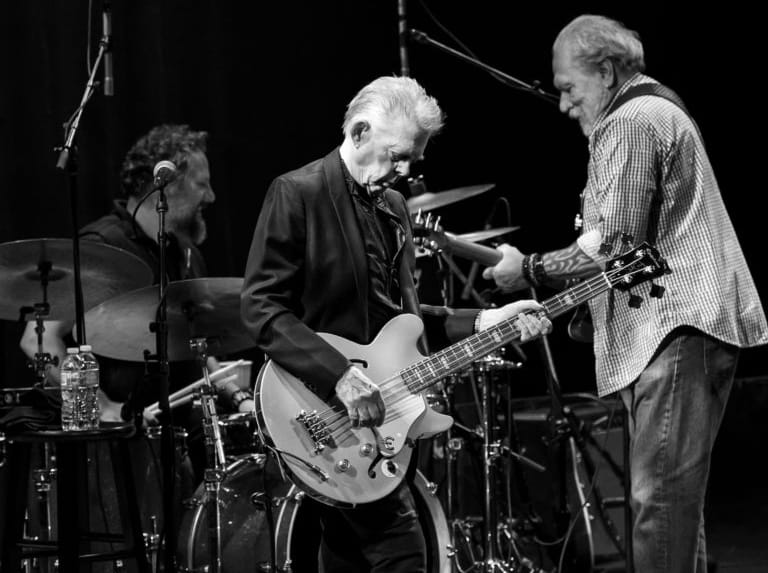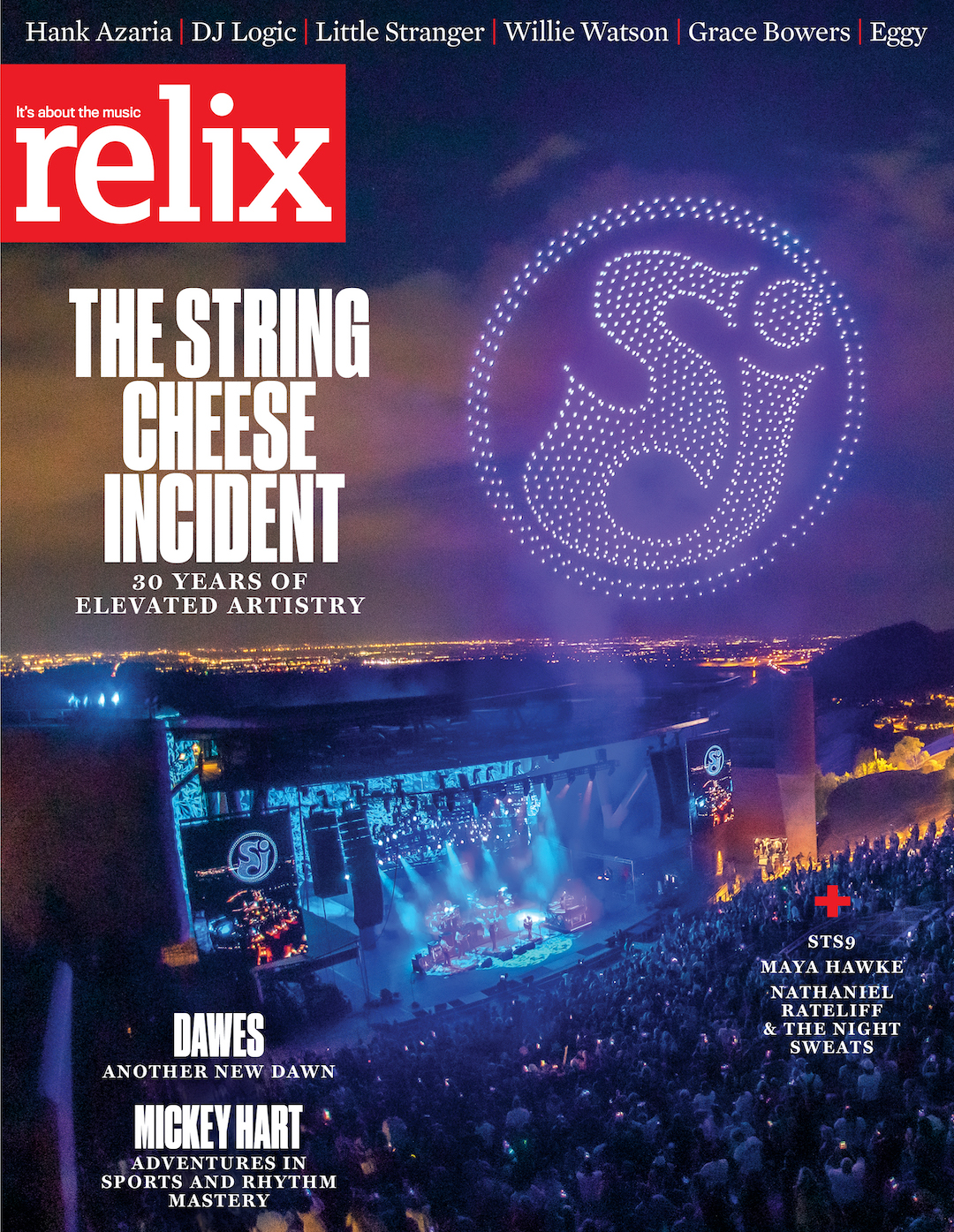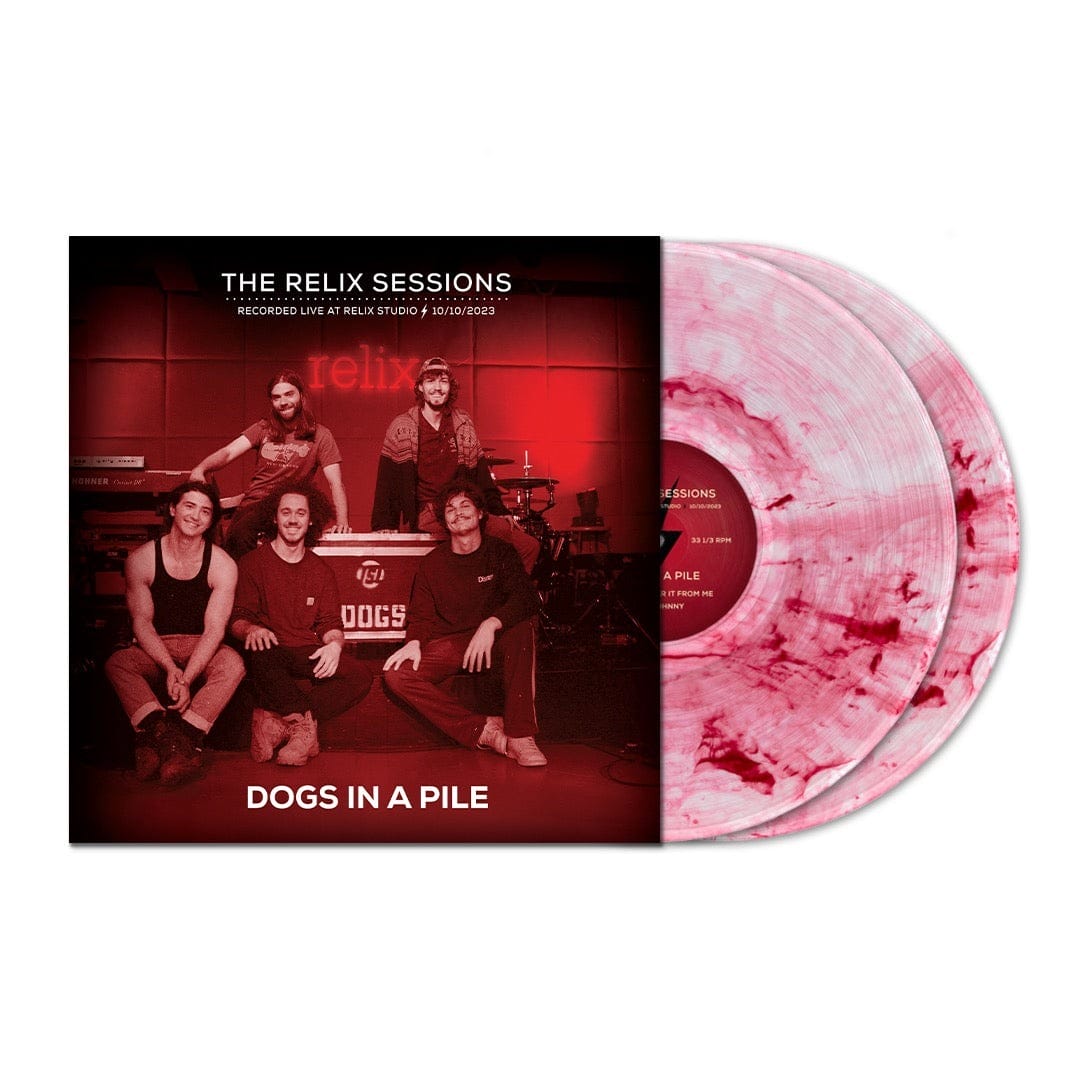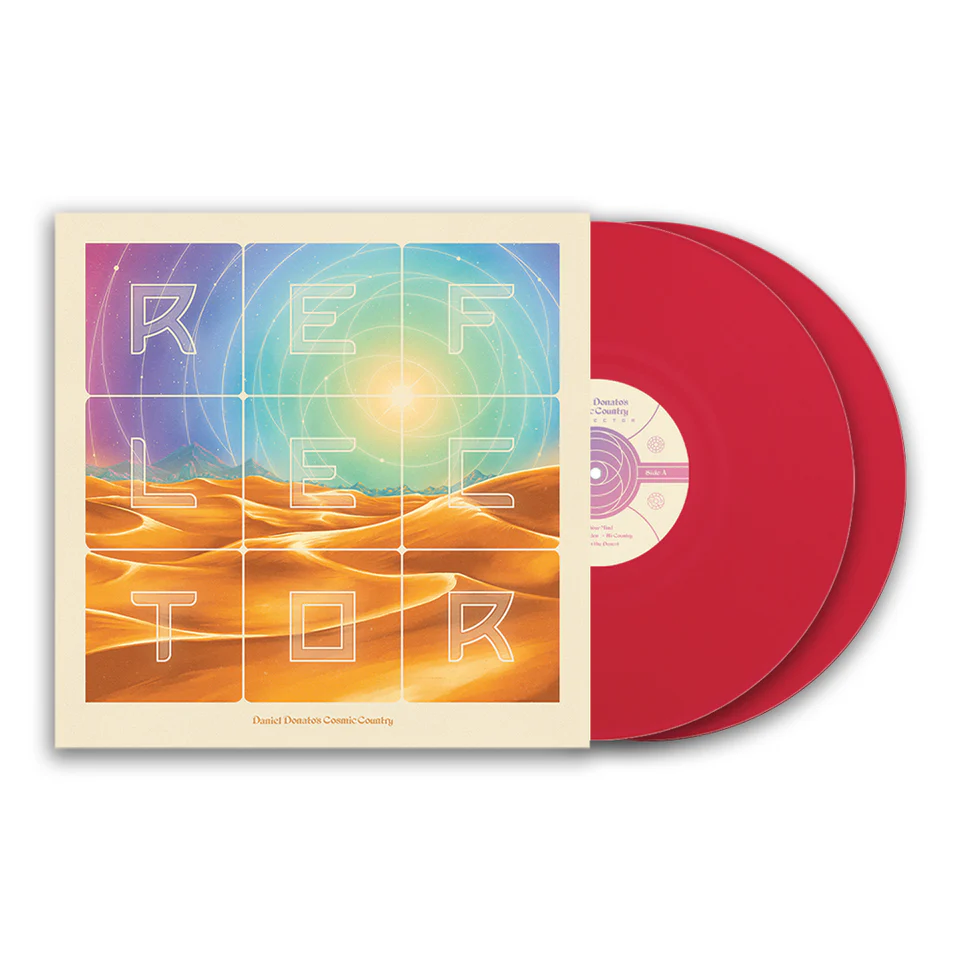Hot Tuna: The Last Electric Waltz

photo: Stevo Rood
***
In May, Jack Casady and Jorma Kaukonen issued a statement regarding the future of their musical partnership. More than five decades after they first performed together as Hot Tuna, they announced that their fall Going Fishing Tour would represent their final electric performances for the foreseeable future.
However, fans took heart in the knowledge that the longtime friends would continue to appear together in the acoustic setting as Hot Tuna, which they have done since 1969. Indeed, as Kaukonen posted on his blog, “It is still our plan to continue in our original duo format. We are not retiring from touring, but the Electric lineup of this long-lived incarnation is going fishing for a while. The road may not go on forever, but the destination is still beyond the horizon.”
Casady, Kaukonen and drummer Justin Guip recently wrapped up three weeks of shows, a number of which featured Steven Bernstein on trumpet. In December, Electric Hot Tuna will reconvene for two gigs at the Fillmore in San Francisco, a place of deep significance for Casady and Kaukonen, who first took flight there with Jefferson Airplane before they set a new course as Hot Tuna. Then it will be on to the Paramount Theatre in Denver to close out the run.
As he considers the full sweep of his creative existence in Hot Tuna, Kaukonen offers, “Whatever the moment requires from us has always been exciting and it still is. We’ve never tried to script things. Playing this music is magical and we continue to revel in it.”
Casady adds, “As we listen to each other and react to the way the dynamics shift and change, we’re still smiling and having a lot of fun. Every time we go onstage, we give a true rendition to the audience. We don’t play songs that aren’t important to us today and we’re not going to give them what we played last night. We’ve always tried to be honest, and I think we’ve been successful at that.”
What prompted the decision to step away from Electric Hot Tuna shows?
JORMA KAUKONEN: I’m going to be 83 years old this year, and I’m fortunate because I’m very healthy, but an electric show just physically beats the piss out of you. At the end of the evening, I don’t want to see people.
I still enjoy doing it because any time I get to play music is a great thing. But after spending two and a half hours on stage holding a heavy guitar, this old man’s ready to go to bed.
JACK CASADY: We will still be touring a lot with Acoustic Hot Tuna, as we have all along. We’ve toured as Acoustic Hot Tuna from the very beginning, as a duo with an acoustic guitar and a bass. We’ve also toured in the electric format, which is basically adding amplifiers, a drummer and a combination of people throughout Hot Tuna’s electric career.
We decided recently, though, that there’s only so much time and only so much energy. Over the last 10 years, we’ve been working with Acoustic Hot Tuna and really just enjoying that world. Jorma is one of the most gifted and sensitive acoustic fingerpicking guitar players that I’ve ever heard. He is not an electric guitar player playing unplugged, where he does the same licks he does on the electric guitar and plays rhythm on the acoustic. So that’s the world where we’ve really been making some interesting strides lately.
The two of you first played together in a Washington, D.C. basement in 1958. As you think back on that, what comes to mind?
JORMA: I met Jack through his older brother, Chick. Jack’s three years younger than me, and his older brother was a year older than me. For some reason, we’ve always had an unintimidating friendship. For lack of a better way to put it—my wife always tells me not to use metaphors like this, but I can’t think of another one— there wasn’t that sort of a swinging dick thing where there’s competition with your buddies. We’ve never had that.
We don’t have band meetings. We’ve respected each other as men and as artists and have thoroughly enjoyed the dialogue that we have when we play music.
There’s that picture floating around of him, me and Warren Smith playing drums back then in Charlotte Harbour’s basement. It was a long time ago, so I can’t remember how long we played and I don’t remember the setlist. What I do remember was that we got about $5 apiece for that gig and we were able to go to the Hot Shoppe—which is a local drive-in restaurant—and get a hamburger afterwards.
Over the years, aside from the fact that various other outside realities have impinged themselves upon us, not much has changed.
JACK: My older brother was an avid record collector, as was my father. He was an audiophile and belonged to the American Jazz Society, so every month we would get something in a brand-new format, an LP—a long-playing record, as opposed to the 78. That’s how ancient I am. They were collections of various jazz artists.
So I started listening early on to Bix Beiderbecke, Eddie Condon and all the ‘20s jazz groups—a lot of stuff from New Orleans. I loved that small combo interplay with all the instruments. Then at the same time—1956, ‘57, ‘58—all the great rock-and-roll and R&B was going on—Little Richard, Hank Ballad & The Midnighters, Ray Charles, Jackie Wilson and Chuck Willis. You also had rockabilly with Gene Vincent and Buddy Holly, as well as the jazz world with John Coltrane, Eric Dolphy, Roland Kirk and all the people that I devoured as much as possible.
I met Jorma around 1957, when I was 13 and a half. He played guitar and sang a little bit and we formed a friendship through music, which would have been highly unlikely if the music wasn’t there, because that’s a pretty large age gap, from 14 to 17. Usually that’s not who you hang out with. But we formed a little band for a year and a half while he finished high school and I finished junior high, playing cover songs of Johnny Cash, Buddy Holly and things like that.
Later on, when Jorma went off to Antioch College, he was sort of reborn as a fingerpicking guitar player after he learned that from Ian Buchanan, a schoolmate. Meanwhile, I started playing in a lot of bands in D.C. One of my good buddies was Danny Gatton, who was a year younger than me and a wunderkind on the guitar. We traded off in each other’s bands.
So as I finished high school, I found myself working three, four nights a week in clubs with the adults, and then I’d be in a homeroom with the kids, so to speak. There was this sort of dual world going on for me.
Jorma, when you invited Jack to join Jefferson Airplane on bass, you had never heard him play that instrument. What does that say about him, not even necessarily as a musician?
JORMA: Well, he’s the kind of guy who’s a perfectionist. So whatever he’s going to do, it’s going to be done well, whether it’s fixing a piece of plumbing, putting some flooring into his house, winterizing his RV, walking his dog or playing music. I knew that when I brought him out to play bass. I’d never heard him play bass, but I’d heard him play guitar and we’d listened to a lot of music together. I just knew he was going to be good. I didn’t know he was going to be that good, but I knew he was going to be good.
Jack, what did that invitation mean to you?
JACK: I was stagnating in Washington at the time. I played night after night for years. When I was 16, I really started working the club circuit, but it was all other people’s music. One night, it’d be rhythm and blues—I’d be playing Ray Charles and Bobby “Blue” Bland in bands that had three saxes, a trumpet and a Wurlitzer piano. Then I’d be doing a country gig or a rockabilly gig. I was doing all these genres of music, but it was never my own stuff, it was always other people’s stuff. Your stuff was never desired by the club owners, so it was really stifling.
I was in college from ‘63-‘65, and Jorma moved out to the West Coast, so we didn’t seen each other a lot for a bit. We used to see each other up in New York City when he was at Antioch. He would do a work furlough where he worked three months in New York and then would go back to Stevo Rood school. I’d take a train up and we’d go to Gerde’s Folk City and see Reverend Gary Davis and Sonny Terry & Brownie McGhee, and all the blues and folk greats of the early ‘60s.
So when he said he’d just joined a folk-rock band, I was in shock. I saw Jorma as a purist on the acoustic guitar. So we laughed and he said, “Yeah, it’s really great. What are you doing?” I said, “I’m going to school, staying out of the army, playing gigs as best I can.” I think he knew that I played bass, but he had never heard me.
When I got out to California, it changed my life completely. I found myself in a band where, even if we did songs that were recorded by other people, we did them our own way. I was responsible for all the music that I made on the bass guitar and held accountable for it.
As I understand it, Hot Tuna began with the two of you playing acoustic in hotel rooms during Jefferson Airplane tours, until one night when Paul Kantner suggested you perform an acoustic tune during an Airplane set.
JACK: That’s just what musicians do. They do it for themselves. You find musicians to play with, then you sit down and play.
Jefferson Airplane had all those talented people for its seven years of existence. We did extraordinary things with that format and even had a couple of hits with the second album.
At the same time, that wasn’t a format for the kind of music we were just beginning to touch upon, drawing out of the more traditional fingerpicking blues and folk worlds that Jorma was coming from. I was coming from a world where I played a lot more R&B and a little bit of jazz, and we were putting those two things together.
We just loved the music. I loved Reverend Gary Davis, I listened to all that stuff. I started out as a guitar player and then moved to bass.
It was just natural to sit down in a nice, quiet environment and hear the acoustic guitar. There’s not a huge amount of volume if you’re not thrashing on the guitar as a rhythm instrument when you’re playing individual notes.
So we played to that atmosphere, and within that atmosphere, we started to discover a lot of the subtleties of the instrument that you don’t hear when it’s piped through an amplifier.
Jorma, can you talk a bit about Reverend Gary Davis and his impact on your music?
JORMA: He has been influential in my life in a lot of profound ways, although I never studied with him. I discovered him through my mentor, who has long since passed away, Ian Buchanan. So, because he studied with the Rev., I got a chance to meet the Reverend a couple of times.
It didn’t make sense for me to play the way he did, though. He played with the two fingers of his right hand and I use three. But there was something so joyful and creative about his playing. It was incredibly sophisticated harmonically, very advanced. He was not a typical blues gospel player of his time, but what he did made sense to me. The Holy Trinity of those guys—the big dog Piedmont players—are Blind Arthur Blake, Blind Boy Fuller and Reverend Davis.
I was never intimidated by his playing, as some people might’ve been, because I never had the skill to mirror other people’s playing. But I’m always there to learn. So while I’m not really a Reverend Gary Davis-style player, his spirit courses through my playing in a lot of ways.
Was there a specific moment that led to the debut of Electric Hot Tuna?
JORMA: There were various incarnations long before it was called Hot Tuna—before we actually said, “Hey, look, we’ve got a band.” When the Airplane first started, we rehearsed eight hours a day. I loved that and I was learning so much about the electric guitar. Then as the band began to age a bit, and as some of the members started families, there just wasn’t that kind of passion anymore for being on the road that Jack and I had.
So in order to fill that void, we had a number of lineups that were almost Airplane, but not quite. We did stuff with Joey Covington, Marty Balin, my brother [Peter] and my buddy Paul Ziegler. We just liked to play.
Then as the coffee grounds began to settle to the bottom, it started to distill itself into a concept that became Hot Tuna. That being said, Hot Tuna has mutated many times over the years, but the core is always Jack and myself.
JACK: We had been playing electric all along. The trick was how to get some of that fingerpicking style of the songs into the electric format. Jorma worked with heavier gauge strings and Stratocaster guitars for the fingerpicking elements.
A lot of the ragtime-y songs lent themselves to a backbeat, which is what they had been doing in New Orleans. But we were doing them in our style, which was more of the Piedmont fingerpicking style that people hadn’t heard in that format. Usually, you couldn’t hear acoustic guitar fingerpicking with a set of drums.
So we transformed some of this stuff, where you could play it with drums in an electric format in front of a large group of people and they would get it.
In Jorma’s blog, he points out that the two of you have probably played 15,000 shows. What’s your reaction to that?
JACK: Well, the 15,000 shows is just part of the whole deal. I’ve always been working on the tone or the melody of songs, and the place where I would experiment was at a show, where I had somebody else to play with me. That’s where I would get another chance to try to open up the door and enter that special world.
I’ve taught for 20-some years at Jorma’s Fur Peace Guitar Camp, and people will ask, “You guys have played so much together, do you even have to rehearse?” Well, it’s the complete opposite. To set up for this tour, we’ve done more rehearsing, more preparation than we ever have before.
It’s kind of like a fighter who spars with a partner in the afternoon. You have to keep your muscles all functioning and keep up to speed. That way, we remain aggressive in our music and approach, so it’s never lackadaisical.
That’s because when we’re onstage, that is the night. You can’t get caught up in what’s happened before. Can you open the door in that special space you’ve got and enter into that room without being distracted by life? If so, then you can get down to work with each other and see what you can discover.
Since this is the final electric tour, what impact has that had on creating setlists?
JORMA: To me, each set is kind of like a song, so I like to have a flow of dynamics. There’s a number of ways to look at the dynamics. One of them is obviously the fingerpicking stuff, which I do on the Chet Atkins SST, as opposed to the balls to the wall rock-and-roll stuff, which is on the Gibson ES-345. I don’t want to berate people’s ears too much without having that flow with the sonic dynamic.
Another thing is that so many of my songs are in Drop D—the king of all alternative tunings—and they have a definite character to them. So I always have a little section in the flow of a set that has at least two Drop D songs together—not just because I don’t have to change tunings, which I can do but I hate to do onstage, but because sonically, it gives people something interesting to listen to rather than the same sort of emotional intensity.
Normally, because we know a lot of songs, I’ll rotate all kinds of songs through the setlist, but because this is our series of final electric gigs, I wanted to be sure that we could really nail every one of these songs every night. I also kept in mind that we’d have Steve on a bunch of the dates. That is not to say we’re going to duplicate every note and every arrangement because that’s not how we play. But I wanted the underpinning to be rock solid, so if we had the opportunity to wander artistically afield, we could still be supported.
Most of the songs we have played for many years, but my quasi-humorous take on it is that we still do these songs because I’m still trying to get them right. The excitement for us, and hopefully for some of the audience members, is that as we’ve learned more about music, we have different takes. It remains a work in progress.
On this tour, you have been performing “Invitation” and “I Don’t Want to Go” for the first time since the mid-‘70s. How did that come about?
JACK: We’d been playing around with “Invitation” for a couple years to get it back up and running. I was working on “Invitation” at home and it’s on the same album as “I Don’t Want to Go.” My stepdaughter, Redbird Stanley, once told me that was her favorite song. It had something to do with when she was in high school and there was something she didn’t want to do. She said she played that song endlessly, much to her mother’s chagrin. So I called Jorma a few weeks before the tour started and I said, “Can you listen and see if we can put it together?” So he did and we did.
We played “Invitation” back in the day, but we hardly ever played “I Don’t Want to Go.” I haven’t used effects in a long time, but I’ve been playing around with them for one of the opening lines on bass.
So we were able to add two songs that we hadn’t done in years.
The other Electric Hot Tuna mainstay for over a decade has been Justin Guip on drums. Can you talk about his contributions?
JORMA: We’ve played with Justin longer than any drummer in our lives. I met Justin in 2009 when I was recording River of Time at Levon’s Studio. Larry Campbell was producing the session. We became friends and companions on a lot of different levels—our wives and kids like each other.
We don’t keep somebody on retainer— we work when we work. So Justin has made himself available and kept himself current with what we’re doing for well over a decade.
We love playing with him. His percussion sensibilities are awesome, and we love hanging out with him, because when you’re out on the road traveling in a bus, the things that irritate you about your friends become apparent after about three days. He doesn’t do anything that irritates me, and I hope I don’t irritate him.
Steven Bernstein takes the music in a lot of unexpected directions. How did he come to join you on certain dates?
JORMA: I like playing with people who make things interesting. I met Steve up at Levon’s Rambles a number of years ago. We later did a tour with Little Feat where they basically had the Ramble horn section with them. Steve was kind of ramrodding that outfit, writing the charts. We were on the road for a number of weeks, and he’s a great guy to hang out with. So we just got to talking and I figured it would be really fun to turn a guy loose on our songs who has his kind of musical and intellectual prowess, to see what happens.
I told him: “You need to know the songs so you’re aware of where they go but I don’t want to rehearse stuff. I don’t want to write parts out. I just want you to get in there and blow and see what happens.” He is the guy for that, which is what makes it so much fun.
At the risk of sounding fatuous and self-serving, when he plays on “Hesitation Blues” with us, I could be in some speakeasy who knows how many years ago. He just brings that to the table. When we turn him loose on a song like “Invitation” or one of these jam tunes like “Bow-Legged Woman” and he plays that slide trumpet through a wah-wah pedal, who would’ve thought of such a thing? He can be as traditional as a Dixieland master or as out as Pharaoh Sanders.
You’re returning to San Francisco to play a couple dates at the Fillmore. What does that venue represent to you?
JORMA: The Fillmore has been hugely important to musicians of my generation and down the line. But a year before the whole San Francisco music thing started to happen for guys like me, I went with my ex-wife to the Fillmore, which was in a Black neighborhood over in the Western Addition. I saw this friend of mine from Oakland named Johnny Talbot with his band Johnny Talbot & De Thangs playing a show with Bobby “Blue” Bland and B.B. King. Those guys were heroes to me, and hearing them in person was unbelievable. Then a scant year or two later, when the Fillmore became a dance hall, it was very exciting for me to be able to play there.
In the beginning, when we first started playing the Fillmore, the stage was maybe two-and-a-half-feet tall. The sound system was barely adequate. Now, of course, it’s a high-tech performing venue that we all love. So there’s a lot of tradition there. For me, that goes way beyond the posters— although I love the posters—and I’m sure I’m not the only one who feels that way.
JACK: Sonically, the Fillmore is just like a big warm blanket around you. The sound in that hall is a part of me because we started our career in that hall with Jefferson Airplane. So I’ve played that hall since 1966 and we look forward to coming back there. I’ll be driving up from Los Angeles, where I live now, and we’re going to play two days there, then jump out to Colorado, do a show there, and that will pretty much wrap up the year and the Electric Hot Tuna.




















